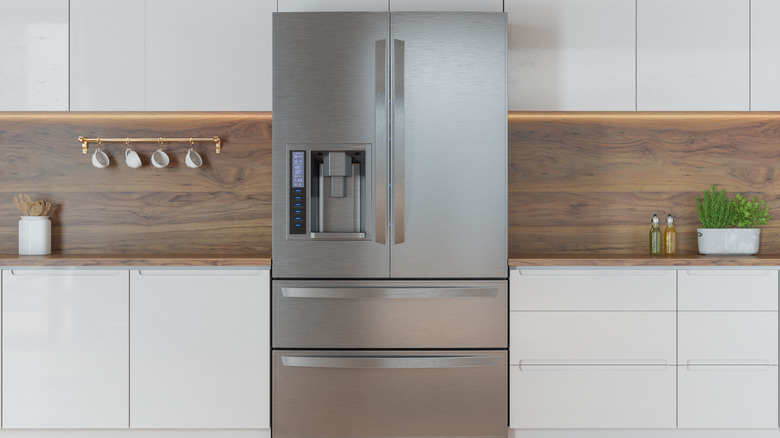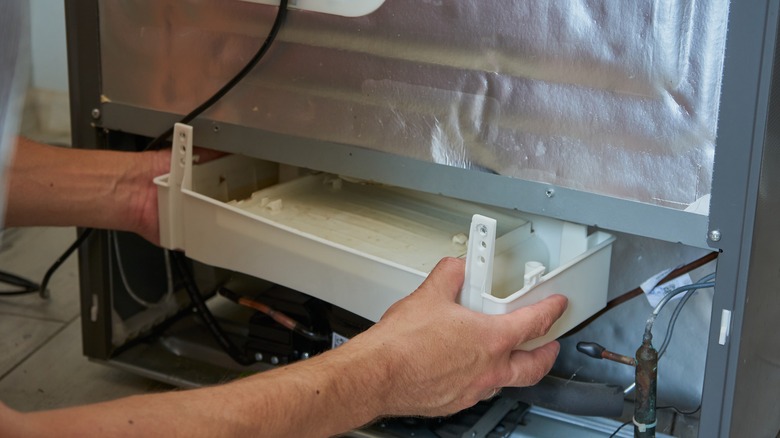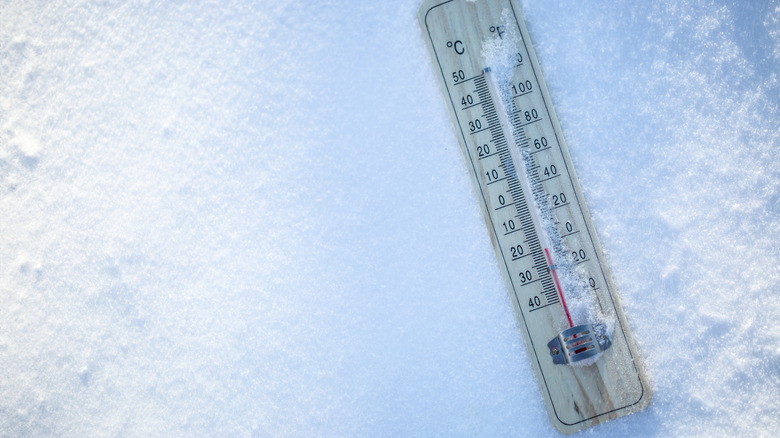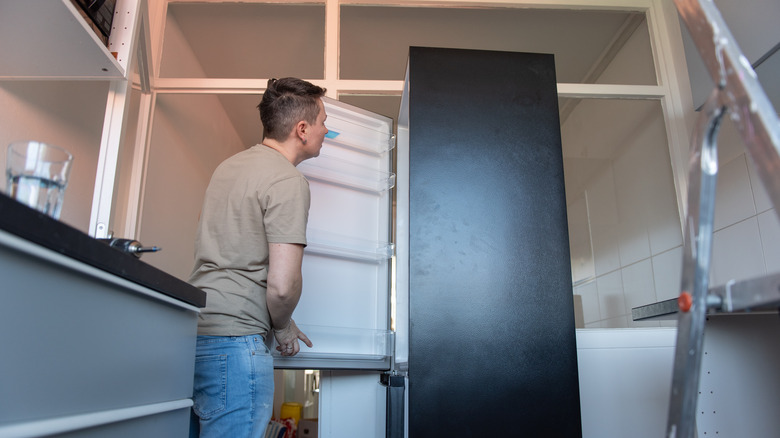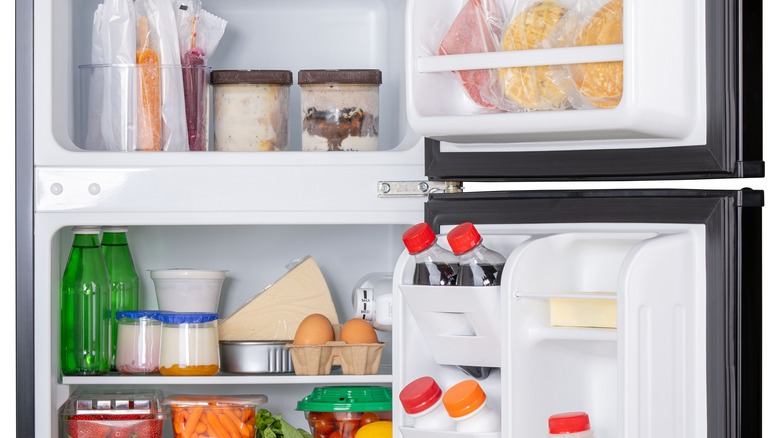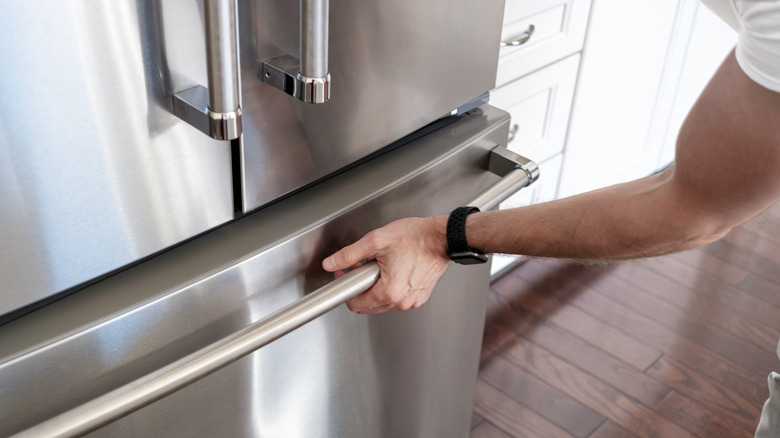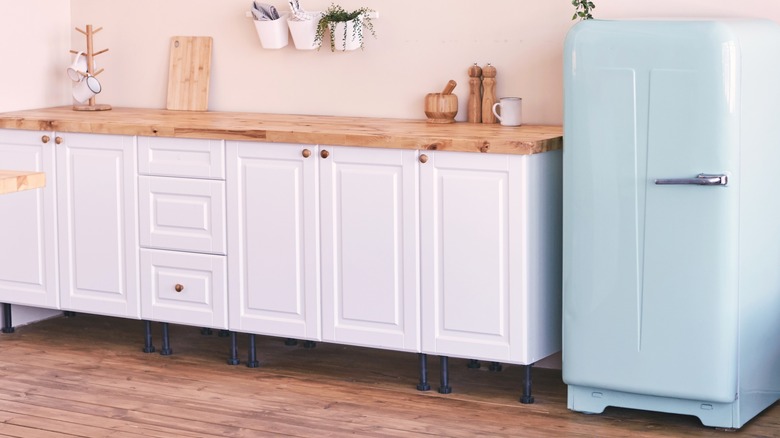11 Annoying Signs You Can't Ignore That Mean You Need To Replace Your Refrigerator
One of life's great ironies is the more important something is in your life, the less time you spend thinking about it. Take your refrigerator, for instance. Most of us never give it a second thought –- we just assume we'll open it in the morning and pull out a chilled bottle of our favorite orange juice, then return later wondering how long that leftover pasta we stuck in the fridge will last. And unlike our ancestors in the pre-refrigeration era, we take it for granted that a bottle of milk we procure on Monday will still taste fresh on Wednesday. How or why refrigerators work rarely crosses our minds -– they just do.
Until they don't. If you've ever endured a days-long power outage, you know how discombobulating life without a functional refrigerator can be. Or if your refrigerator suddenly starts doing strange things or not cooling things down as efficiently as before, you may suspect trouble is ahead –- but how much trouble you're up against is still a mystery. While many refrigerator malfunctions can be resolved with simple repairs, others are signs that it's time for a new fridge. Here to share when to repair and when to replace your main kitchen appliance are three experts who spoke exclusively with Chowhound: Jason Siciliano, vice president of marketing and communications and creative director at Allstate Protection Plans, Ian Palmer-Smith, appliance repair expert at Domestic & General, and Sofia Wang, senior performance marketing specialist of EMPAVA Appliances.
Frost buildup is a sign of trouble
In past decades, frost buildup in freezers was considered normal, and a routine (if dreaded) kitchen chore was to empty the freezer and manually scrape all the frost off. Today's freezers, however, come with either auto-defrost functions, which briefly heat up the walls of the freezer to dissolve any ice crystals, or built-in fans that remove warm air from the freezer before it has a chance to cause condensation and frost.
Thus, unless you're hanging on to a vintage refrigerator or freezer, defrosting should not be necessary. That means any frost buildup you spot in a new fridge is a sign of trouble. The frost can have a number of root causes, ranging from air leaks from a defective door seal or an overworked system. While simple maintenance (such as cleaning out fans, vents, and condenser coils) can correct some of these issues, refrigerator frost can also be a sign of a fridge with bigger problems -– in which case, it may make more sense to replace it than repair it.
Leaks may escalate and become bigger issues
Water leaks aren't always fatal problems for a refrigerator, but if left untreated, they can escalate into bigger problems both inside and outside of your fridge, such as electrical shock or floor damage. In addition, leaks are symptoms of other technical issues that can compromise the performance of your refrigerator. Modern refrigerators are designed to control and cleanly drain off excess moisture, and water leaks can result when one of mechanisms for moisture control fails.
For instance, refrigerators have condensation drains in the back to shunt away any excess moisture. However, if this drain becomes clogged with food, dirt, or ice, water may leak instead into your refrigerator or onto your floor. A related problem is a damaged drain pan –- this pan in the back of the unit holds drained-off water (there shouldn't be much) until it can evaporate. But if the pan is leaking or clogged itself, it can allow water to leak onto the floor. A potentially more serious problem that can contribute to leaks is frost, which can cause leakage as it melts. This is not only annoying but also a possible sign of a failing motor, and a signal that your refrigerator may have run its course.
Unsteady temperatures may mean a failing system
Your refrigerator has one job: to keep your food cold. So if it is working extra hard to stay cold, you'll need to figure out why. "If your fridge is struggling to maintain a steady temperature, it could be cause for concern," Ian Palmer-Smith says. "If the fridge is unable to maintain a consistent, cool temperature, it could lead to fast food spoilage."
While an unsteady temperature can indicate a serious defect, sometimes simple solutions can correct the problem. For instance, improper air circulation could affect temperature control –- you need at least an inch of clearance behind your fridge and half an inch around the sides for adequate circulation. Thus, you may be able to solve the problem just by moving your refrigerator away from a wall. Clogged or dirty air vents or even improperly set temperature controls may also cause your refrigerator to act up. Finally, Palmer-Smith notes, your refrigerator will work best if it's not crammed to capacity with food (plus, some foods actually fare better when stored outside the refrigerator.) "Make sure you are storing your food properly, avoiding overcrowding, and ensuring good air circulation, before deciding to get a new fridge," he advises.
Grinding noises may hint at big problems
We're all used to the little sounds our refrigerators sometimes make –- an occasional low whirring noise or the sound of ice cubes dropping from the ice maker. But if you start to hear new or unusual sounds, it could be a sign of a bigger problem. "A soft hum or occasional clicks is totally normal," Jason Siciliano says. "But if your fridge is banging, grinding, or squealing, that's a sign of trouble — likely a failing compressor or fan that needs attention. Since these are some of the most expensive parts to fix, it's worth checking if your appliance is covered under a protection plan before paying out of pocket."
Before you panic, be sure to rule out other causes first. "It's worth remembering that a very common cause of noise is a non-secure drain pan on the compressor, so make sure to check that this is not the culprit first, as simply tightening the screws should fix this," Ian Palmer-Smith explains. And depending on what service is needed, this may also be the time to decide whether it's smarter to repair or replace your refrigerator. A big factor in your decision is your refrigerator's recent track record. "As a general rule, if a repair seems relatively simple and your fridge is not too old, then it's best to get it fixed," Palmer-Smith says. "On the other hand, if your refrigerator is old and unreliable, it might be time to look into getting a replacement."
Hot spots on the outside of the fridge could warn of something more concerning
There's something disconcerting about running your hand absently along the outside of your refrigerator and noticing a suspiciously hot spot. Yes, this happens sometimes, but yes, you're right to be concerned. "Blocked vents or a bad fan could be to blame," Jason Siciliano says. "If the outside feels unusually hot, dirty coils or an overworked compressor might be the culprit — time for a cleaning or service call."
Some parts of the surface, however, may sometimes be warmer than others as part of their normal operation. For instance, the top of the refrigerator may feel warm just after you load it with food or during times when you're opening and closing the doors frequently. This is due to the activation of heat loops, which prevent frost from forming on the outside of the refrigerator. But if the top of your refrigerator feels hot all the time, something is wrong. The condenser may be clogged, which can impede airflow and raise the temperature.
Excess condensation is a big red flag
A bit of humidity in your refrigerator will help keep your food fresh -– but while occasional signs of condensation are normal, constantly wet refrigerator walls are a big red flag. "One of the most obvious signs your fridge needs replacing is excessive condensation," Ian Palmer-Smith says. "If you notice an unusual amount of condensation on the outside of your fridge or around the edges of the door, this might indicate that your appliance is not cooling properly and needs to be replaced."
As we've seen, a number of mechanical factors can contribute to improper cooling and thus to condensation. These can be as simple and fixable as a damaged seal around the door, which can cause the refrigerator to leak cold air and thus trigger condensation. But it could also mean it's time to look for a new refrigerator. But no matter what the cause, don't let the problem slide — excess condensation can lead to unhygienic conditions in your refrigerator. "Aim for 30%-40% humidity inside your fridge to keep food fresh. Too much moisture can lead to mold, while too little can dry out produce," Jason Siciliano explains.
Rising energy bills could mean your fridge is struggling
Even if your refrigerator seems to be functioning decently, it might be sending you a cry for help –- in the form of your power usage. So if your electricity bill has skyrocketed for no obvious reason in recent months, it may be because your refrigerator is working overtime to stay cool. "I've helped many of my customers indicate whether their fridges need to be replaced, and I'd say the most sneaky indicator that most people miss is when your fridge starts draining your wallet," Sofia Wang explains. "A spike in your energy bills is a clear sign that it's time to replace your unit."
Believe it or not, your struggling refrigerator can indeed wreck serious havoc on your budget. "An inefficient fridge can jack up your energy bills by as much as 30%, according to the U.S. Department of Energy — could be $150-plus a year for the average household!" Wang says. And while shelling out for a new fridge is a big financial commitment, the experts said the investment would be worth it. "While replacing your fridge can be expensive, newer models are usually much more energy-efficient, so replacing your old one can hopefully save you money in the long run," Ian Palmer-Smith adds.
A constantly running refrigerator is a bad sign
It's normal to hear your refrigerator hum from time to time –- but according to Sofia Wang, a refrigerator that runs audibly around the clock is likely on its last legs. You can think of it as the difference between a trained runner who can easily hold a conversation while running and an out-of-shape newbie who pants loudly at every step. Just as out-of-shape athletes have to work harder to cover the same ground as their better-conditioned counterparts, an over-the-hill fridge has to work harder to function at a normal level.
"For instance, in a healthy refrigerator, the compressor will cycle on for around 15-20 minutes each hour," Wang explains. "But if you hear that motor running constantly, it's a warning sign." So if your fridge has become noisier than usual, keep an eye on your power bills. "I suggest tracking your energy bill for a few months and listening to your fridge's behavior," Wang notes. "If it's running too much and your bills are rising, it's a sign that the appliance is falling short of its efficiency."
Food that spoils more quickly than before indicates something is wrong
Most of us won't notice minor changes in refrigerator temperature –- but the food inside can tell, even if we can't. Even a shift of a few degrees can make the difference between fresh food and spoilage. If you notice your food going bad sooner than it did before, it's a sign your refrigerator isn't doing its job.
If you notice this happening, check for the simplest and most fixable causes first. For instance, it's possible that someone or something accidentally bumped the temperature gauge. Or maybe you've been stuffing too much food in the fridge, which can restrict airflow around all the items and thus hinder effective cooling. (Strategic positioning of food in your refrigerator can help alleviate this problem.) For reference, the ideal temperature for the main compartment of a refrigerator is between 35 degrees and 38 degrees Fahrenheit -– if you're not sure you trust the temperature gauge, put a thermometer in the refrigerator to double-check it. But if the root cause of the spoilage is a struggling motor, it may be time for a new fridge.
Cracks in the shell may or may not be fixable
One of the most obvious signs of a broken refrigerator is a visible crack in the interior or exterior shell. This can be more than just a cosmetic problem –- cracks can allow cold air to escape, which will raise the temperature of your refrigerator and force it to work harder. While hairline cracks aren't generally a problem, if you notice a change in refrigerator temperature along with the crack, you need to take action.
Cracks have a number of causes, including impact with heavy or sharp objects or extreme cold. If your refrigerator functions normally despite the cracks, you can fix them yourself with epoxy or refrigerator liner tape. Bigger cracks, however, are difficult to repair (fridge liners can't be replaced) and can compromise the structural integrity of your fridge as well as its cooling power. So if you find growing cracks and warmer temperatures in your fridge, it's time to start looking for a replacement.
A refrigerator that's over 10 years old may have reached its limit
Many of us have fond memories of visiting an older relative's home and always seeing the same Brady Bunch-era refrigerator still humming along and loaded with treats just for you. Your grandmother's or uncle's refrigerator is no quirk: Back in the day, refrigerators were built to last. Not only were they made of more durable materials (such as metal instead of plastic), but they were also mechanically much simpler and were designed to be easy to repair.
Alas, the same cannot be said for modern refrigerators. While they're more affordable and more energy-efficient than their predecessors, they're also made of cheaper, less-durable materials. In addition, many come loaded with electronics, which can be tricky to repair and make diagnosing problems more difficult. As a result, you can realistically expect a new refrigerator to last between 10 and 20 years. Bottom-freeze models generally last longer than side-by side models, and built-in models last longer than standard ones. So if your refrigerator is over 10 years and old facing expensive repairs, your wisest move might be to replace it.
